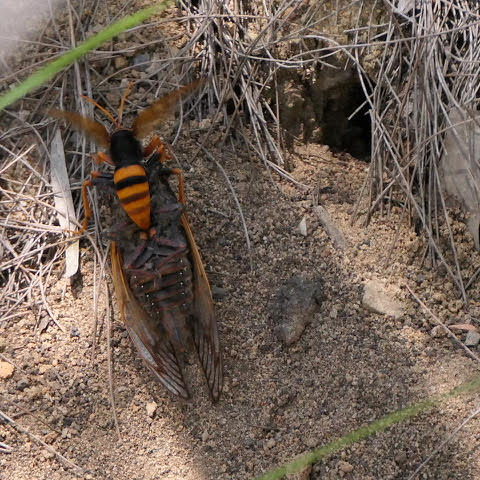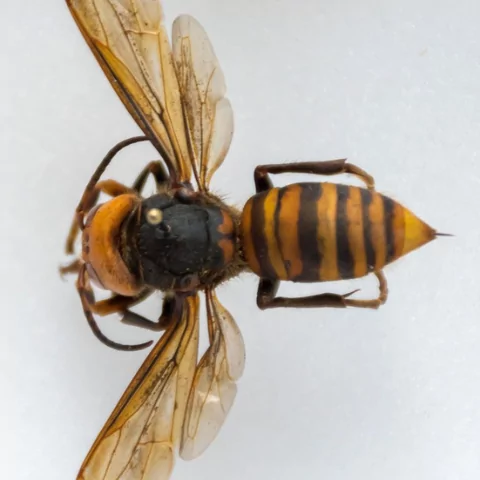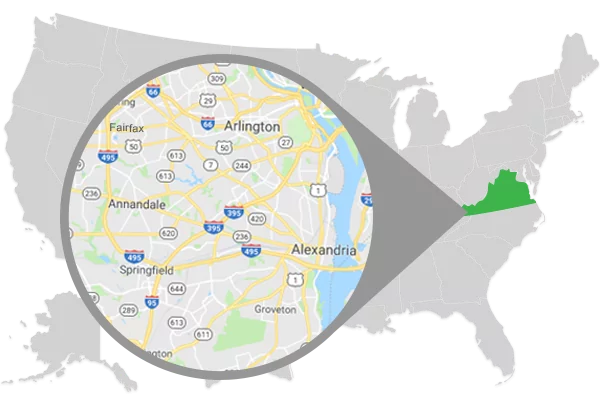What is the difference between cicada killer wasps and Asian giant Hornets?

Photo Credit: Cicada Mania
What are cicada killer wasps?
Cicada killer wasps are the largest wasp in the world. There are four different species of them in the United States, the Western cicada killer, the Eastern cicada killer and the Pacific and Caribbean cicada killer wasps. In Northern Virginia, the most commonly found species of cicada killer wasp is the Eastern cicada killer wasp. The Eastern cicada killer wasp typically can grow to be up to one and a half inches long. They have stripes along their abdomen that are jagged and resemble mountain ranges. They are abundant in Northern Virginia during the late summer months of July and August and start leaving the state toward mid September. Their main source of prey is adult cicadas hence their name.
The male cicada killers don’t have stingers and are therefore harmless to people but female killers do have stingers but very rarely will sting people. However, females will use their stingers on cicadas and inject venom in them that paralyzes them. Pets are also more at risk of being stung than people and may experience allergic reactions to the venom especially if they are stung on their face or mouth. Cicada killer wasps are a natural form of pest control because while cicadas don’t have stingers, the way they lay their eggs often causes damage to trees and other plants. Cicada killer wasps dig burrows underground and fill them with the cicadas that they have paralyzed to feed their larvae or babies. Cicada killer wasps are solitary insects and do not socialize or build their habitat with other insects. The females are only social for the purpose of mating and will raise their young on their own.

Photo Credit: Penn State
What are Asian giant hornets?
Asian giant hornets more commonly referred to as murder hornets are the largest species of hornets in the world. They are two inch long, orange and black-striped hornets. The wingspan of a queen is about two and a half inches to three inches long, with the workers tending to be smaller both in length and wingspan. Asian giant hornets are called murder hornets because they viciously attack and Asian giant bee populations by ripping their heads from their bodies. The main threat is to already dwindling bee populations. The Asian giant hornets rip the heads off of honeybees and take the lower half of their body or thorax with them to eat and also feed their young. In addition to being a threat to honeybees, they are also potentially dangerous to humans. They are very aggressive and protective of their nests and will sting people if they feel threatened. Like many other stinging insects they possess a potent venom that may cause an allergic reaction for people. Native to parts of south, southeast and east Asia as well as parts of Russia, the Asian giant hornet was most likely introduced to the United States through a freight ship off the pacific northwest coast. The first sightings were in late 2019 and there have been at least three more sightings of Asian giant hornets in the United States, two being queens and the first male was reported in California.
What is the difference between the two species?
It can be difficult to tell the two species apart just from looking at them. They are both large, striped flying insects. The main way to differentiate between the two of them is to understand the differences between hornets and wasps. Hornets are actually a kind of wasp and there are over 100,000 known species of wasps. One major difference between the two, is hornets and generally plumper and larger than wasps. Asian giant hornets are also a light orange color with smooth black or brown stripes whereas cicada killer wasps are a light yellow with black ridge-like stripes. The Asian giant hornet can sting through a bee suit and their sting has about seven times more venom than the average honeybee. It is much more likely that you will see a cicada killer wasp in Northern Virginia than the Asian giant hornet since they are still low in numbers and have not made their way from the west.
Why should we worry about them?
While there haven’t been any sightings of the Asian giant hornets in Virginia, there have been sightings in other states and they seem to be headed east. Cicada killer wasps are prevalent in Virginia and can cause property damage. When they are building their burrows they can displace up to several pounds of soil. They can burrow under tiles or parts of patios and sidewalks and raise them. A good way to know if you have a cicada killer wasp problem on your property is to look for random soil deposits or a change in the placement of soil. A good way to know if you have a Asian giant hornet problem on your property is if you find heads of honeybees laying around. Asian giant hornets can decimate an entire hive of honeybees in under an hour. Honeybees are crucial members of our ecosystem and act as pollinators for plants and other vegetation. Asian giant hornets may also potentially threaten the yellowjacket population in ways similar to the honeybees if given a chance. It is important to make sure this invasive species doesn’t spread and further colonize in the United States. The department of agriculture hopes to locate any Asian giant hornet nests before the colonies reproduce and to try to eradicate them.
What can be done about them?
When dealing with any kind of pest, in particular stinging insects, it is important to let a professional service like Summit Wildlife Removal handle the job. Even though cicada killer wasps are not known to sting, they must be handled with care and by someone who is skilled and trained in effectively removing them and their nest. They may cause damage to the areas where they build their nests. If you think you might have a cicada killer wasp problem on your property, contact us and we can help determine what the issue is and resolve it.












